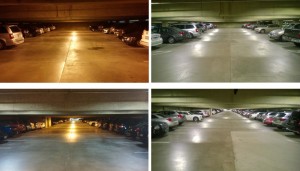Metro Shines a Light on Sustainability – and Wants Your Bright Ideas!
New garage lighting initiative demonstrates the power of innovative thinking (and partnerships)
Last spring you read about Metro’s initiative to replace 13,500 light fixtures with high-efficiency light-emitting diode (LED) lights. This investment would brighten and make safer Metro’s garages while cutting energy costs by utilizing state-of-the art lighting, monitoring, motion-sensing, and remote management technology.
Good news – Metro has completed the first set of installations at our Huntington garage and is rolling this technology out to the remainder of our structured parking facilities. Check out a video of the project underway!
Notably, this initiative is the product of a private partnership with Phillips and the launch of innovative performance-based contracting at WMATA. Philips self-financed and is installing, and maintaining the lighting system for 10 years. In return, WMATA makes pre-set “service” payments only if Philips can produce the energy savings they have guaranteed. WMATA will continue to pay the energy bills for lighting in the garages, but because the garages cost less to light, Phillips can get paid out of the cost savings over the 10-year contract cycle.
Just as important as the “what” in this story is the “how”. Bidders had the latitude to propose a solution they thought was the most cost-effective way to meet WMATA’s lighting and other requirements over the life of the contract. By letting the private sector design their best solutions to our problem, WMATA was able to benefit from the outside ideas and expertise while transferring risks of deploying new technologies to vendors who stood behind their product. And in the end, the region gets improved facilities and more sustainable transit.
We at the Office of Planning hope that this can be just the beginning of the journey towards innovative partnerships with the private sector. There are certainly loads of ideas out there for ways in which energy-savvy innovations can drive bottom line savings and be suitable for performance-based relationships with private firms. We also want to pay attention to what our customers are telling us in recent surveys – that investments in sustainability are the most popular ways to achieve operating cost savings in WMATA budgets.
Each year the Sustainability Lab tests out new ideas for large-scale deployment and we would love to have your help in finding the next big idea like marrying wayside energy storage and regenerative braking capacity or on-board cameras that might help buses issue parking violations to illegally parked cars that keep our buses stuck in traffic instead of zipping along. Whatever the idea, we’d love to hear your thoughts and consider them.
So help us think big! Submit your ideas online or email them to planning@wmata.com.



If Montreal’s STM can use escalators that slow or stop when not in use, why not WMATA?
Agree with other comments about the escalators that slow or stop when not in use (activated by people stepping on the panels at the top or bottom). The Brussels metro uses them and they are very effective, especially in the shorter escalators (platform to mezzanine).
I always thought the ticket machines (so many at each station) always being on wasted a lot of energy. Possibly use the model of self check outs or copiers that don’t turn on (are basically in sleep mode) until a button is pushed.
While outdoor stations could benefit from more solar panels to provide lighting and energy efficient bulbs behind maps and on signs could improve visibility and reduce power.
1) Escalators should auto-slow as suggested above. Station staff should be required to turn off escalators when there are more than needed to handle non-rush hour traffic. (Example: turn off one of the 3 escalators at Takoma). Re-examine replacing some of the shorter escalators with staircases in cases where 3+ escalators are available for a given transit.
2) re-examine lighting throughout stations, especially outdoor platforms, parking lots, etc. A lot of this is just horribly inefficient – sending light up to the sky, or lighting a dingy concrete surface, far more than the areas that need to be lit – the places where people are standing or walking.
@DavidDuck – I like the idea of expanding the effort shown in the video to explore parking lots or other outdoor lighting areas. Keep the ideas coming!
@ Matt – How else might we get those backlit maps/signs to be smarter energy consumers and smarter products overall?
I encourage you to get your ideas into us via the online submission form or by emailing a suggestion to planning@wmata.com. Keep the ideas coming!
1. Purchase battery buses, such as Proterra. These are claimed to have lower lifetime costs of ownership, in addition to zero emissions and reduced energy consumption.
2. If your HQ has a cafeteria, purchase a Vegawatt (http://www.vegawatt.com) plant to burn the waste grease for power and hot water. The payback period is around 2 years.
3. Be more ambitious with the LEDs. Train signals and the blue lights along outdoor tracks can be replaced. Single-color LEDs are cheaper than white ones. Consider lighting stations and tunnels with LEDs. This last idea has two benefits: reduced energy and mercury consumption.